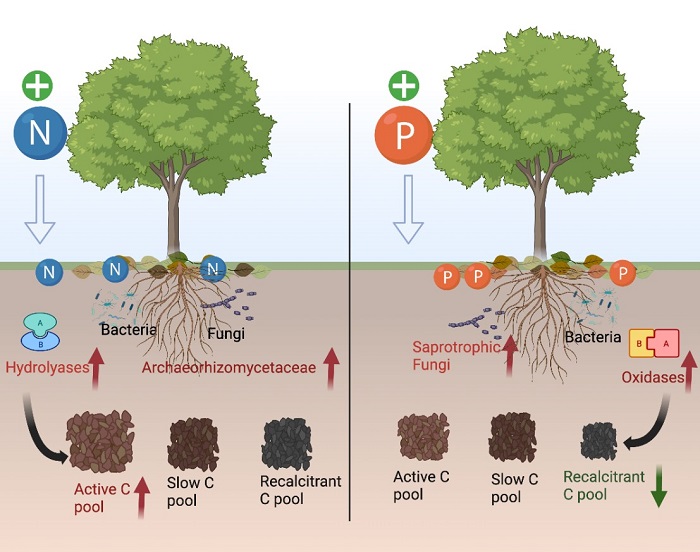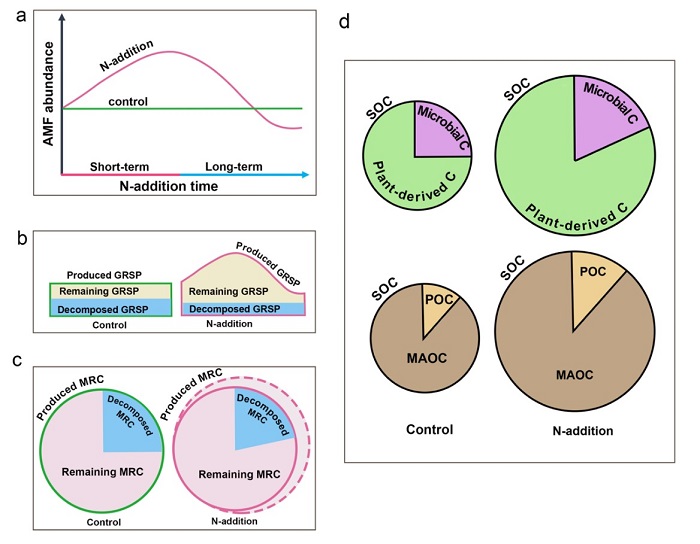

Soil is the largest carbon (C) reservoir of terrestrial ecosystems, and at least half of soil organic carbon is stored in forests. Tropical and subtropical forests play a vital role in the global forest carbon cycle, accounting for 78% of total global forest carbon emissions and 55% of total carbon uptake. Human activities also lead to increased atmospheric nitrogen (N) deposition, which changes the carbon sequestration capacity of forest soil by affecting plant growth and microbial activity. However, there are still many deficiencies in the research on how nitrogen deposition affects the low-phosphorus tropical forest soil carbon pool and its components.
Researchers from Xiaoliang Station took advantage of a long-term (14 years) N and phosphorus (P) addition experiment in tropical forests and studied the effects of N and P addition on soil organic carbon (SOC) and its different C fractions, as well as the microbial residual C. They found that N deposition increased the total SOC pool, and mainly increased the active C pools, while P addition significantly reduced the recalcitrant C pools and tended to reduce the total SOC. Further analysis of soil enzyme activity and fungal community composition showed that P addition increased the activity of some oxidase enzymes and the expression of oxidase-related genes in soil. This indicates that the high N and low P environment in tropical areas benefits SOC sequestration, but mainly the active C pools, and while its stability decreases. This study was published online at Ecological Indicators, entitled with “Nitrogen deposition in low-phosphorus tropical forests benefits soil C sequestration but not stabilization”, for detailed information, see https://www.sciencedirect.com/science/article/pii/S1470160X22012341
On this basis, researchers in Xiaoliang Station further analyzed the changes of microbial carbon components in soil under the background of N deposition. Total GRSP, MRC, and SOC concentrations were higher under N addition, but soil microbial biomass and community composition were largely unaffected, indicating that higher GRSP and MRC concentrations resulted from the long-term accumulation and reduced microbial degradation. However, the relative contributions of GRSP or MRC to SOC were unchanged or lower than the controls due to a greater contribution of other C sources to SOC which were largely unstabilized by association with soil minerals. Tropical forests have great potential for SOC sequestration in response to N deposition which may help mitigate climate change. However, most of the additional SOC in N-fertilized soils was not associated with soil minerals, and thus prone to decomposition. This study was published online at Plant and Soil, titled with “Nitrogen deposition enhances soil organic carbon and microbial residual carbon in a tropical forest”, for detailed information, see https://doi.org/10.1007/s11104-022-05787-6
The above-mentioned research results have been supported by the National Natural Science Foundation of China, the R & D program of Guangdong Provincial Department of Science and Technology, the CAS Youth Innovation Promotion Association (2021347) and the CAS Project for Young Scientists in Basic Research.

Figure 1. The conceptual diagram showing the trend of total SOC and its different C pool in tropical forest under N and P addition and the underlying microbial mechanisms.

Figure 2. Conceptual diagram showing the effect of accumulation of GRSP and MRC on SOC content and potential microbial mechanisms under nitrogen deposition conditions.

